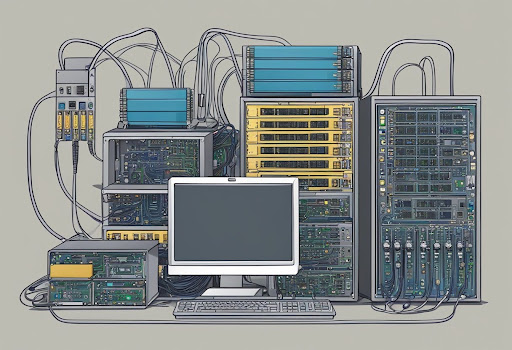Subprocessor Selection: Ensuring Security and Compliance in Data Operations
By Emily Fenton
Updated February 6, 2024

In the realm of data protection, a subprocessor plays a crucial role in the handling of personal data. A subprocessor is a third-party entity engaged by a primary data processor to manage personal data on their behalf. This arrangement is particularly common in complex IT ecosystems, where a company may outsource certain tasks to specialists.
The subprocessor must adhere to the same legal and regulatory requirements as the main processor, particularly under regulations like the General Data Protection Regulation (GDPR).
Understanding the dynamics between data controllers, processors, and subprocessors is vital for maintaining the integrity of personal data. Data controllers are responsible for ensuring that their processors, as well as any engaged subprocessors, comply with data protection laws and industry standards. The clarity of roles and responsibilities, along with adherence to data processing principles, is essential in building trust and ensuring accountability in data processing activities.
With the increasing need for data processors to scale their operations and specialize their services, the use of subprocessors is becoming more prevalent. It's imperative that data controllers assess and monitor their processors' choice of subprocessors to avoid potential data breaches and ensure that personal data is always managed with the utmost care. The transfer and processing of personal data by subprocessors should always fall within the legal framework established to protect individual privacy rights.
Understanding Subprocessors
In contemporary data management, subprocessors play a critical role within the data processing ecosystem, handling data on behalf of processors and controllers with due diligence.
Definition of Subprocessor
A subprocessor is a third-party entity that is engaged by a data processor to conduct data processing activities. This arrangement is essential when a data processor must extend its capabilities or scale operations, often to manage specialized tasks or provide enhanced services. Learn more about what a Subprocessor is in the article here.
Subprocessor Management
Effective subprocessor management ensures the integrity and security of data handled by third parties on behalf of a primary data processor. It requires meticulous scrutiny in the selection and management of subprocessors.
Selection Criteria
Companies establish stringent selection criteria for subprocessors to assure alignment with legal and security standards. Criteria often include the subprocessor's technical capabilities, compliance with industry-specific regulations, and the ability to enforce data privacy standards. For example, Microsoft requires potential subprocessors to demonstrate compliance with its Supplier Security and Privacy Assurance Program before they can process any customer data on Microsoft's behalf.
Due Diligence Process
Due diligence is a critical step, involving a thorough assessment of the subprocessor's operational history, security practices, and previous compliance audits. This process aims to identify any potential risks in granting them access to sensitive data.
Contractual Obligations
Subprocessors are bound by contractual obligations to adhere to the data protection and privacy terms set by the primary processor. These contracts usually detail data handling requirements, incident response protocols, and remedies for breaches. It also usually specifies the nature of data that can be accessed, ensuring that subprocessors can only process, store, or access data within the agreed scope.
Compliance and Legal Considerations

In the context of data processing, compliance and legal considerations are integral to managing risks and ensuring adherence to regulatory frameworks. Subprocessors must act within the parameters of data protection laws and uphold the obligations outlined in subprocessor agreements.
Data Protection Laws
Under data protection laws, subprocessors are accountable for safeguarding personal data and ensuring privacy rights. They are bound by the same legal requirements as processors, such as the General Data Protection Regulation (GDPR), which mandates that subprocessors follow strict data protection and privacy protocols.
Subprocessor Agreements
The relationships between controllers, processors, and subprocessors are governed by formal contracts. These subprocessor agreements articulate the responsibilities and expectations of each party, ensuring subprocessors process data solely based on the processor's directives.
Audits and Inspections
To maintain transparency and compliance, subprocessors may undergo regular audits and inspections. These procedures assess the effectiveness of security measures and the level of compliance with legal obligations, often requiring subprocessors to provide evidence of their data processing practices.
Subprocessor Lists and Documentation

Subprocessor lists are essential for data management and demonstrate a company's commitment to data privacy and transparency. They ensure that all parties involved in data processing are acknowledged and monitored.
Maintaining a Subprocessor List
Companies must keep an up-to-date list of subprocessors that handle customer or personal data. This list typically includes the names of the subprocessors, the services they provide, and the data they process.
Transparency Requirements
Transparency in subprocessor engagements necessitates clear communication to stakeholders. Data processors are required to publish their subprocessor lists and inform customers of any new additions. The LivePerson subprocessor page is a testament to this practice, as it provides detailed information about each subprocessor to uphold its commitments under the Data Processing Addendum and it offers users an easy tool to communicate any changes to the LivePerson subprocessor list.
Risk Management

When entities employ subprocessors, detailed risk management is a critical aspect of maintaining data security and complying with legal obligations. This entails the thorough evaluation of risks and the implementation of strategies to mitigate potential threats.
Risk Assessment
Risk assessment involves identifying potential risks associated with the involvement of a subprocessor and gauging their likelihood and impact. This systematic process includes:
-
Cataloguing subprocessors and outlining their roles and responsibilities.
-
Evaluating the data privacy and information security policies of the subprocessor.
-
Analyzing potential threats and vulnerabilities within the subprocessor's operation.
A well-conducted risk assessment ensures that an organization understands the security implications of outsourcing data processing tasks.
Mitigation Strategies
After assessing risks, organizations must adopt mitigation strategies to manage and reduce the potential impact of working with subprocessors. Effective strategies include:
-
Contractual safeguards: Binding agreements that ensure subprocessors are adopting adequate security measures and are compliant with established standards, including GDPR obligations, read more about these obligations here.
-
Regular audits: Conducting periodic reviews and audits of subprocessors to verify compliance and data handling practices.
-
Data processing agreements (DPAs): Creating comprehensive DPAs that define the terms and conditions, roles, responsibilities, and liabilities of all parties involved.
By implementing these mitigation strategies, an organization can significantly reduce the risks associated with data subprocessors.
Change Management

In the context of subprocessors, change management involves systematic handling of the introduction or replacement of subprocessors and ensuring relevant stakeholders are appropriately notified.
Adding or Replacing Subprocessors
When a company plans to add or replace a subprocessor, it must first assess the impact on the services provided as well as compliance with relevant data protection regulations. For example, Microsoft's change guide outlines the importance of a change management plan. They describe three phases that help maintain the integrity and security of data throughout the transition process, adhering to GDPR requirements when Microsoft acts as a data processor.
The assessment should include:
- The technical and security capabilities of the new subprocessor.
- Legal implications, particularly concerning data privacy laws.
- Continuity planning to prevent service disruption.
The company should document each decision, action, and its rationale in a Change Management Log.
Stakeholder Notification
Communicating with stakeholders is paramount in the change management process. The company must ensure stakeholders are informed about changes to subprocessors in a timely and clear manner.
Notifications should include:
- The identity of the new subprocessor.
- Reasons for the change.
- Expected impact on stakeholders.
Workday's subprocessor page illustrates transparency in subprocessor changes. They detail modifications in their subprocessor engagement, thereby giving stakeholders insight into the shifts within Workday's operational structure.
Recommended Reading: Want to learn how to alert your website visitors when your subprocessors are updated?
Best Practices and Recommendations
When it comes to handling personal data, subprocessors play a vital role. Here are several best practices and recommendations that should be followed:
-
Contractual Agreements: Subprocessors should have clear contractual terms with the data processor, specifying their responsibilities and compliance obligations under privacy laws like the GDPR.
-
Data Protection Measures: Implement and maintain robust technical and organizational measures to protect personal data against unauthorized or unlawful processing.
-
Transparency: Maintain high transparency levels in processing activities. It is essential to document all subprocessor arrangements and ensure they comply with global privacy regulations.
-
Risk Management: Continuously assess and manage risks associated with subprocessors, as this is a core component of complying with global privacy regulations.
-
Audit and Compliance: Regular audits should be conducted to ensure subprocessors adhere to agreed-upon standards and legal requirements.
Here is a checklist for selecting a subprocessor:
- Ensure they have a good reputation and are compliant with relevant data protection laws.
- Confirm they have the necessary safeguards for data security.
- Verify their capability to meet the contract terms, including reporting and audit rights.
In essence, both data controllers and processors must diligently oversee their subprocessors to ensure the protection and confidentiality of the personal data they handle.
Emerging Trends and Future Outlook
The landscape of subprocessors is continually evolving, with trends highlighting a strategic integration of digital transformation. Manufacturers are advised to embrace these advancements, as detailed by Deloitte Insights, indicating a pivot towards a more competitive and resilient future. These entities play a crucial role in handling data, often serving as third-party data processors for various services.
In the realm of technology, artificial intelligence (AI) stands as a significant trend to be observed. The integration of AI into subprocessor services is expected to expand, strengthening business analytics and customer engagement.
Another trend to watch is the heightened focus on data privacy and compliance, with subprocessors being pivotal in personal data processing related to personnel.
- Adoption of AI: Increasing utility in processing and analytics.
- Digital Transformation: Embracing new technologies for efficiency.
- Data Privacy: Upholding stringent data protection standards.
The industry's future points towards a landscape where subprocessors not only ensure operational efficiencies but also become custodians of ethical data management. Companies are anticipated to refine their selection of subprocessors, preferring those who demonstrate robust security measures and proactive compliance with international regulations.
Want to monitor web changes that impact your business?
Sign up with Visualping to get alerted of important updates, from anywhere online.
Emily Fenton
Emily is the Product Marketing Manager at Visualping. She has a degree in English Literature and a Masters in Management. When she’s not researching and writing about all things Visualping, she loves exploring new restaurants, playing guitar and petting her cats